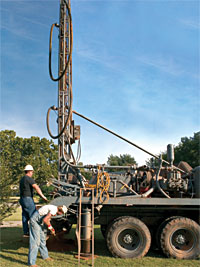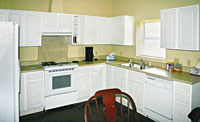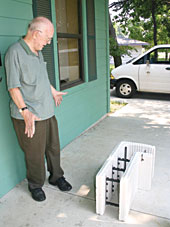
The organization recently presented the Millennium House in Tulsa, Okla., as a prototype of how to build an affordable home designed to offer the benefits of lower operating costs, higher energy efficiency, storm and fire resistance, and healthy IAQ for families on limited incomes.
"Low- to moderate-income families are the ones who really need the benefits of lower utility bills," said Don McCarthy, project coordinator for Neighbor For Neighbor. "Buying a home is one thing, but being able to afford to live in it is another. The Millennium House demonstrates that it is possible to build a total electric home for about $50,000 to $60,000, using quality materials that produce healthy, safe, and energy-efficient structures."
McCarthy coordinated the project with a concert of organizations and individuals who sponsored the labor and materials. Everything from the ClimateMaster geothermal heating and cooling system to the Whirlpool washer and dryer contribute to a home that averages as little as $19 a month in operating cost. The Oklahoma Senate Bill 610 tax credits, reduction on insurance premiums, and low cost of construction also contribute to the affordability of the house.
"We have the technology," said Dan Ellis, president of ClimateMaster. "Let's get it to the folks who need it. The geothermal water-source heat pump offers an economical, energy-efficient, and environmentally sound method for heating and cooling a home. The payback begins on the first day of operation."

Low Cost To Operate
According to McCarthy, the average monthly operating costs confirms the performance forecasted for the house and falls well within the parameters of the project's mission.According to the nonprofit organization, the data for the past six months on the Millennium House documents an average operating cost of $230 per year to heat and cool the structure. According to officials, the lowest electric bill was $28.06, with 80 percent of the amount accounting for electricity usage for lights, appliances, etc.
The remaining amount subtracted from the average monthly bill equates to approximately $9 to $20 a month to heat and cool the home. A hot water generator, attached to the geothermal unit, supplements the energy for heating the domestic hot water.
Additionally, the recently passed tax credits offered to Oklahoma residents for energy-efficient investments in residential properties up to 2,000 square feet, should offer significant incentives for builders and municipalities to duplicate the Millennium House for other communities.
"We could not be more pleased with the results of the Millennium House project," said Ann Smith, executive director of Neighbor For Neighbor. "We are now in the process of selecting a family to move into the home."
The Millennium House is recognized by the American Lung Association and Energy Star program, and meets the requirements of the Americans with Disabilities Act. Meeting the requirements of each organization required a little forethought in the beginning to produce benefits at the completion of the project. The presence of hydrocarbons is eliminated with the total electric utilities, the doors widths and level living spaces allow for wheelchair access, and the insulated concrete walls provide energy efficiency and are considered one of the most fire-resistant construction materials. The main bathroom is constructed as a safe room to meet the Federal Emergency Management Agency (FEMA) specifications for withstanding an F5 tornado.

Project History
After McCarthy purchased the lot for $300, Manhattan Construction Co. agreed to build the 1,200 square-foot prototype house using Insulating Concrete Forms (ICF) construction. The ICF construction is basically built with polystyrene forms for the poured concrete walls, which stay in place as a permanent part of the wall assembly. The walls are 12 inches thick, compared to the 4- or 5-inch walls of the average home.Building these walls cost $1 to $4 per-square-foot more than a typical new U.S. home, according to the Insulating Concrete Form Association. This type of form, plus concrete construction, has a reduced time schedule and volunteers provided all the labor, which made it very cost effective. In addition, the studs and ancillary framework of the interior walls are steel, which greatly reduces the potential for fire damage.
The basic exterior wall construction is designed to withstand an F3 tornado. The trusses are also secured to the walls with hurricane clips. These re-enforced walls also block outside noise and provide indoor comfort through energy efficiency.
Although floor plans are standardized, exterior finishes are available in a variety of designs, providing individuality for the homeowners.
Publication date: 10/03/2005

Report Abusive Comment